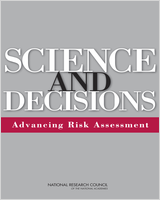NCBI Bookshelf. A service of the National Library of Medicine, National Institutes of Health.
Risk assessment has become a dominant public policy tool for making choices, based on limited resources, to protect public health and the environment. It has been instrumental to the mission of the U.S. Environmental Protection Agency (EPA) as well as other federal agencies in evaluating public health concerns, informing regulatory and technological decisions, prioritizing research needs and funding, and in developing approaches for cost-benefit analysis.
However, risk assessment is at a crossroads. Despite advances in the field, risk assessment faces a number of significant challenges including lengthy delays in making complex decisions; lack of data leading to significant uncertainty in risk assessments; and many chemicals in the marketplace that have not been evaluated and emerging agents requiring assessment.
Science and Decisions makes practical scientific and technical recommendations to address these challenges. This book is a complement to the widely used 1983 National Academies book, Risk Assessment in the Federal Government (also known as the Red Book). The earlier book established a framework for the concepts and conduct of risk assessment that has been adopted by numerous expert committees, regulatory agencies, and public health institutions. The new book embeds these concepts within a broader framework for risk-based decision-making. Together, these are essential references for those working in the regulatory and public health fields.
Contents
- THE NATIONAL ACADEMIES
- COMMITTEE ON IMPROVING RISK ANALYSIS APPROACHES USED BY THE U.S. ENVIRONMENTAL PROTECTION AGENCY
- BOARD ON ENVIRONMENTAL STUDIES AND TOXICOLOGY
- OTHER REPORTS OF THE BOARD ON ENVIRONMENTAL STUDIES AND TOXICOLOGY
- Preface
- Abbreviations
- Summary
- 1. Introduction
- 2. Evolution and Use of Risk Assessment in the Environmental Protection Agency: Current Practice and Future Prospects
- 3. The Design of Risk Assessments
- 4. Uncertainty and Variability: The Recurring and Recalcitrant Elements of Risk Assessment
- 5. Toward a Unified Approach to Dose-Response Assessment
- 6. Selection and Use of Defaults
- CURRENT ENVIRONMENTAL PROTECTION AGENCY POLICY ON DEFAULTS
- THE ENVIRONMENTAL PROTECTION AGENCY’S SYSTEM OF DEFAULTS
- COMPLICATIONS INTRODUCED BY USE OF DEFAULTS
- ENHANCEMENTS OF THE ENVIRONMENTAL PROTECTION AGENCY’S DEFAULT APPROACH
- PERFORMING MULTIPLE RISK CHARACTERIZATIONS FOR ALTERNATIVE MODELS
- CONCLUSIONS AND RECOMMENDATIONS
- REFERENCES
- 7. Implementing Cumulative Risk Assessment
- 8. Improving the Utility of Risk Assessment
- 9. Toward Improved Risk-Based Decision-Making
- Appendixes
- Appendix A Biographic Information on the Committee on Improving Risk Analysis Approaches Used by the Environmental Protection Agency
- Appendix B Statement of Task of the Committee on Improving Risk Analysis Approaches Used by the Environmental Protection Agency
- Appendix C Timeline of Selected Environmental Protection Agency Risk-Assessment Activities
- Appendix D Environmental Protection Agency Response to Recommendations from Selected NRC Reports: Policy, Activity, and Practice
- Appendix E Environmental Protection Agency Program and Region Responses to Questions from the Committee
- Appendix F Case Studies of the Framework for Risk-Based Decision-Making
This project was supported by Contract EP-C-06-056 between the National Academy of Sciences and the U.S. Environmental Protection Agency. Any opinions, findings, conclusions, or recommendations expressed in this publication are those of the authors and do not necessarily reflect the view of the organizations or agencies that provided support for this project.
NOTICE: The project that is the subject of this report was approved by the Governing Board of the National Research Council, whose members are drawn from the councils of the National Academy of Sciences, the National Academy of Engineering, and the Institute of Medicine. The members of the committee responsible for the report were chosen for their special competences and with regard for appropriate balance.
- NLM CatalogRelated NLM Catalog Entries
- Review Risk management frameworks for human health and environmental risks.[J Toxicol Environ Health B Cri...]Review Risk management frameworks for human health and environmental risks.Jardine C, Hrudey S, Shortreed J, Craig L, Krewski D, Furgal C, McColl S. J Toxicol Environ Health B Crit Rev. 2003 Nov-Dec; 6(6):569-720.
- Review Policy decision-making under scientific uncertainty: radiological risk assessment and the role of expert advisory groups.[Health Phys. 2009]Review Policy decision-making under scientific uncertainty: radiological risk assessment and the role of expert advisory groups.Mossman KL. Health Phys. 2009 Aug; 97(2):101-6.
- Review Environmental Decisions in the Face of Uncertainty[ 2013]Review Environmental Decisions in the Face of UncertaintyCommittee on Decision Making Under Uncertainty, Board on Population Health and Public Health Practice, Institute of Medicine. 2013 May 20
- A web-based tool to engage stakeholders in informing research planning for future decisions on emerging materials.[Sci Total Environ. 2014]A web-based tool to engage stakeholders in informing research planning for future decisions on emerging materials.Powers CM, Grieger KD, Hendren CO, Meacham CA, Gurevich G, Lassiter MG, Money ES, Lloyd JM, Beaulieu SM. Sci Total Environ. 2014 Feb 1; 470-471:660-8. Epub 2013 Oct 29.
- A look at state-level risk assessment in the United States: making decisions in the absence of federal risk values.[Risk Anal. 2013]A look at state-level risk assessment in the United States: making decisions in the absence of federal risk values.Effio DG, Kroner O, Maier A, Hayes W, Willis A, Strawson J. Risk Anal. 2013 Jan; 33(1):54-67. Epub 2012 May 31.
- Science and DecisionsScience and Decisions
Your browsing activity is empty.
Activity recording is turned off.
See more...
